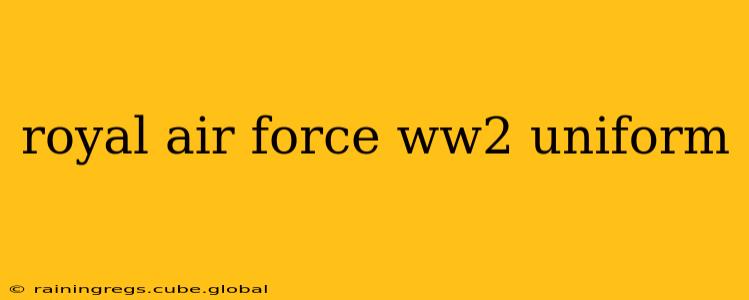The Royal Air Force (RAF) played a pivotal role in World War II, and its uniforms reflected both the evolving nature of air warfare and the distinct identity of the service. Understanding the intricacies of RAF WWII uniforms offers a fascinating glimpse into the history and culture of this vital branch of the British military. This guide delves into the various aspects of RAF uniforms during the war years, addressing common questions and providing detailed insights.
What did RAF pilots wear in WWII?
RAF pilot uniforms varied depending on the role and context. For flying duties, the standard was a flying suit, typically made of durable, often leather, material offering protection from the elements and potential injuries. These suits were often complemented by a leather flying helmet and goggles. For ground duties and off-duty wear, officers would typically wear a service dress uniform, consisting of a tunic, trousers, and tie, often in blue or sometimes grey depending on the branch and occasion. Rank insignia was clearly displayed on both flying and service dress uniforms. The iconic RAF blue uniform became synonymous with the service during this era, although variations in color and materials existed.
What were the different RAF uniforms during WWII?
The RAF utilized a range of uniforms tailored to specific roles and situations:
- Flying Suits: As mentioned, these were practical, durable suits designed for flight operations. Variations existed based on the season and operational needs.
- Service Dress: This was the standard uniform worn for non-flying duties, parades, and official occasions. The style and materials varied slightly over the course of the war.
- Battle Dress: A more rugged, field-appropriate uniform, utilized for ground crew and those operating in less formal settings.
- Tropical Dress: Adapted for warmer climates, this uniform was worn by RAF personnel stationed in regions with hotter temperatures.
How did RAF uniforms differ from other WWII uniforms?
While sharing some commonalities with other British military uniforms (such as the use of rank insignia and general structure), RAF uniforms possessed distinct features:
- Blue as the primary colour: Unlike the khaki of the Army or the dark blue of the Navy, the RAF adopted a distinctive shade of blue for its service dress, clearly distinguishing its members.
- Specialized flying suits: The development of specialized flying suits, tailored to the demands of aerial combat, set the RAF apart.
- Insignia: The RAF's insignia, featuring a winged lion, further differentiated it from other branches.
What were the common accessories worn with RAF uniforms?
Accessories played an important role in completing the RAF uniform:
- Pilot's Helmet & Goggles: Essential for flight operations, these protected pilots from the elements and provided clear vision.
- Parachute Harness: Part of a pilot's flying equipment, the harness was integrated into the uniform system.
- Rank Insignia: Clearly displayed on uniforms to denote rank and authority.
- Badges and Medals: Awarded for service and bravery, medals and other badges added a personal touch and symbolized accomplishments.
What did RAF ground crew wear in WWII?
RAF ground crew wore a variety of uniforms depending on their specific role and location. Battle Dress was frequently used, while other personnel might wear variants of the service dress or specialized overalls and protective gear for maintenance tasks. Their uniforms prioritized practicality and durability, reflecting the demands of their roles.
This overview provides a glimpse into the diverse world of RAF uniforms during World War II. Further research into specific roles, units, and theatres of operation will reveal even greater detail and nuance. The uniforms themselves represent a tangible connection to a pivotal era in military history, serving as a testament to the bravery and dedication of the men and women who served in the Royal Air Force.
